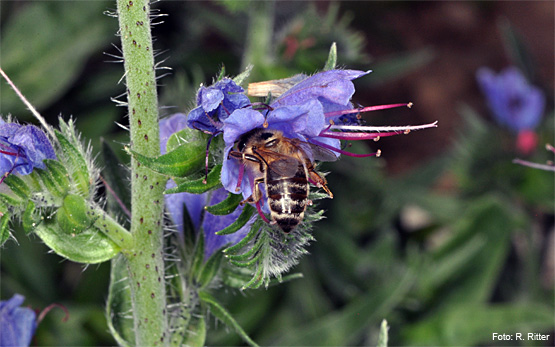When bees gather nectar and pollen from plants containing PAs, they bring these plant toxins into the hive. Through the consumption of honey and bee bread, adult bees are directly exposed to these PAs. Our experiments showed that adult bees tolerate PAs relatively well. Honey-bee larvae, however, were very sensitive to PAs. Even small amounts of PAs were lethal for the larvae. Even so, we were able to show that only a small fraction of the PAs from the bee bread actually ends up in the royal jelly. Feeding jelly to the sensitive larvae protects them from plant toxins.

Are pyrrolizidine alkaloids (PAs) toxic for bees?
Pyrrolizidine Alkaloids (PAs) in Swiss honey
The wide distribution of plants containing PAs means that these undesirable plant substances occur in tea, honey and other foods, and can represent a risk for consumers. Our studies of PAs in Swiss honey showed that this product normally poses very little risk for the consumer. Honey from locations with a high presence of PA-containing plants, especially viper’s bugloss (Echium vulgare) constitutes the exception here. Echium-type PAs are the most common PAs in Swiss honey, and are mainly carried into the honey by the bees via the nectar.
Pyrrolizidine Alkaloids (PAs) in Swiss pollen
We also investigated the contamination of Swiss-produced pollen with PAs. Viper’s bugloss and hemp agrimony (Eupatorium cannabinum) were the main sources of PAs in positive pollen samples. Beekeepers are therefore advised to avoid especially large areas of viper’s bugloss plants in the vicinity of the hives. By ending pollen collection at the beginning of July, beekeepers can avoid hemp agrimony-type alkaloids.





